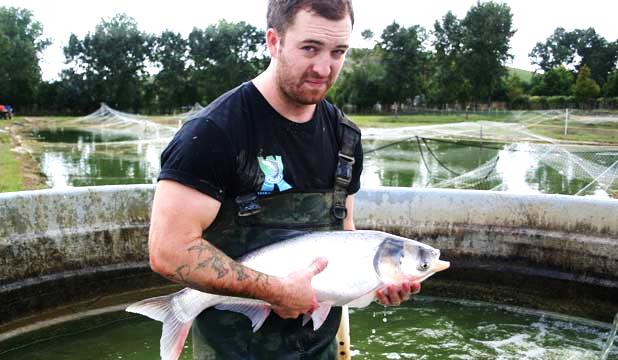
Grass carp (silver carp) bred in NZ and suitable for IMTA
The main objective is to increase the productivity of water, land and associated resources while contributing to increased food fish production.
The main linkages between agro-livestock activities and fish culture (Integrated Agri-Aquaculture Systems – IAAS) involve the direct use of crop/livestock wastes, as well as the recycling of crop or manure-based nutrients which function as fertilisers to stimulate natural food webs. These food webs are algal and zooplankton blooms which provide “free” food to aquatic species that graze on the blooms.
Integrated Multi-Trophic Aquaculture (IMTA) is a practice in which the by-products (wastes) from one species are recycled to become inputs (fertilizers, food) for another. Fish fed in a pond produce faeces (nutrients) which in turn can be utilised by plants. These plants may be a crop (e.g. tomatoes or watercress). Alternatively the nutrients may be used to create micro-algal and zooplankton blooms in ponds which may feed other fish species that graze on these blooms.
"Multi-Trophic" refers to the incorporation of species from different trophic or nutritional levels in the same system. This is one potential distinction from the age-old practice of aquatic polyculture, which could simply be the co-culture of different fish species from the same trophic level.
Ideally, the biological and chemical processes in an IMTA system should balance. This is achieved through the appropriate selection and proportions of different species providing different ecosystem functions. The co-cultured species are typically more than just “biofilters” - they are harvestable crops of commercial value. A working IMTA system can result in greater total production based on mutual benefits to the co-cultured species and improved ecosystem health, even if the production of individual species is lower than in a monoculture over a short term period.
Sometimes the term "Integrated Aquaculture" is used to describe the integration of monocultures through water transfer. For all intents and purposes however, the terms "IMTA" and "integrated aquaculture" differ only in their degree of descriptiveness. Aquaponics, fractionated aquaculture, IAAS (integrated agriculture-aquaculture systems), IPUAS (integrated peri-urban-aquaculture systems), and IFAS (integrated fisheries-aquaculture systems) are other variations of the IMTA concept.
The advantages of IMTA are:
Disadvantages of IMTA are:
The potential applications of land based IMTA in New Zealand are:
The limits of aquaculture integration options are boundless. The following diagram shows a range of integration and zero waste farming options.

Example of a Zero-Waste agriculture system that utilises IMTA principles

Organic aquaponics production integrated with freshwater fish production (Greenling, Texas)
There is limited information, within the New Zealand context, to give any reliable costs and potential returns for IMTA systems. The range of integration options are diverse and the interactions complex. NPFL suggests that you seek expert advice before embarking on an IMTA venture.
The following links contain general information on integrated aquaculture (IMTA).